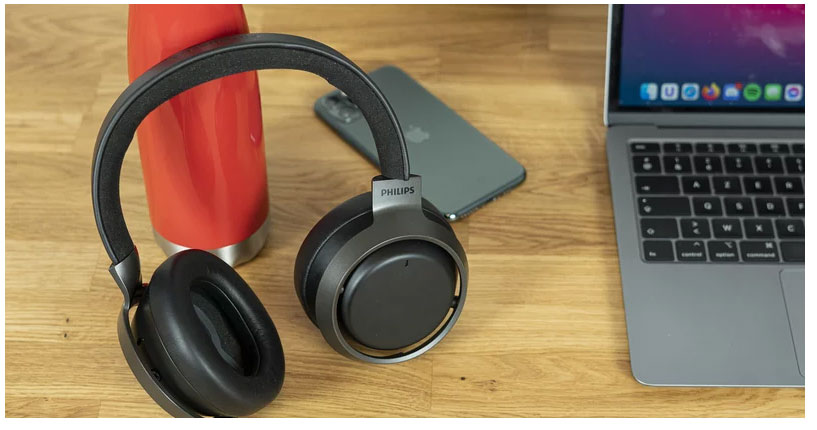Philips Fidelio L3
The Fidelio L3 inaugurates the new philosophy of high-end mobile headphones from Philips. No more open acoustic architecture, the new version enters the nomadic era with Bluetooth connection and active noise reduction.
Overview
In its drive to renew the Fidelio range, Philips is drastically changing the philosophy of its Fidelio L headphone range. The changes to the Fidelio L3 are so numerous compared to the L2 of 2013 that it becomes difficult to find a link between the two headphones.
In addition to a completely redesigned headset, the Fidelio L3 is also subject to numerous updates. It must be said that in 8 years, the tech world has evolved a lot and that yesterday's nomadism is not at all the same as today's. The Fidelio L3 therefore bids farewell to the open acoustic design of its predecessors and welcomes Bluetooth and active noise reduction with open arms to bring itself up to date. Still, Philips assures that the audiophile philosophy of the Fidelio L lineup is retained by proudly holding up the aptX HD codec compatibility and the much sought-after Hi-Res badge.
Manufacturing & accessories
Philips has been working hard to find a new visual identity for the revival of its high-end headphones and it must be said that the execution is particularly successful. The Fidelio L3 has a refined design that is reminiscent of the Fidelio X3, which also seduced us with its elegance and manufacturing quality.
The earpieces are composed of a matt black plastic shell topped by a beautiful aluminum frame. They swivel 90° to the back so that the ear pads rest gently on the collarbones when worn around the neck. However, they are not foldable. The headband is covered with real leather to reinforce the premium aspect of the helmet. It is relatively flexible and offers a good travel, which will delight the strongest heads.
Alongside the Fidelio L3, the box includes a cover as well as a pouch to carry the headset safely. It also comes with a 50cm USB-A to USB-C charging cable, a 130cm 3.5mm to 2.5mm mini-jack auxiliary cable and a dual airplane adapter. It would have been nice if the Fidelio L3 had switched to a standard mini-jack connector since the 2.5mm format is very rare today.
Comfort & fit
The aluminum structure certainly brings a certain cachet to the headset, but it also weighs down. The 360 g of the Fidelio L3 is not a featherweight, especially when compared to the 255 g of the WH-1000XM4. In this respect, the Philips headset is much closer to Apple's Airpods Max in the category of headphones that are hard to forget when worn. Such weight is particularly noticeable at the focal point of contact between the headband and the top of the skull. But that's not all, the stiffness of the headband and the small amount of earcup travel cause a pronounced pinching effect, precisely under the ear, at the level of the jaw, which even large ear cushions can't compensate. It should also be noted that the headset is very hot in the ears, which may bother some people.
But even with these many unfortunate points, the Fidelio L3 is still quite pleasant to use on a daily basis. The round design of the earpieces and the consequent depth of the cushions make it possible to slip in any size of ear without feeling any discomfort.
User experience
The Fidelio L3 offers a very similar user experience to the WH-1000XM4. Both headsets have a touch-sensitive surface on the outside of the right earpiece to perform a variety of actions: call management, volume control, track navigation... nothing is missing. These controls are also very responsive and obey the finger and eye, perhaps even a little too much: it is not uncommon to trigger an action because of a bad manipulation. On the same headset, there is also a physical button for changing the listening mode (switching between noise reduction, "transparent" mode and passive mode) and a second to trigger the phone's voice assistant.
All these actions are accompanied by voice prompts in English and beeps to facilitate the handling of the headset. There is no way to know the remaining battery level from the headset, but it knows how to remind you when it runs out of juice. A voice will whisper "battery low" every ten minutes once the 30% mark is passed, which is quickly annoying.
Powering up and pairing is done with a physical button located on the left earpiece. The Fidelio L3 is the first in its family to integrate Bluetooth (compatible with SBC, AAC, aptX and aptX HD codecs) and even has multipoint functionality allowing it to be connected to two different sources at the same time. It is also quite possible to use the headphones in wired mode thanks to the 2.5 mm mini-jack sub input, provided that the headphones are left on; they cannot be used in passive mode. The button to manage the listening modes remains operational, but the other controls are disabled.
To take it a step further, you can download the Philips Headphones app available on iOS and Android. It includes a battery level indication, a six-band equalizer, noise reduction management options and an automatic headphone shutdown function after a set time (only on iOS). It's also possible to disable auto-pause when the headphones are removed from the head within this app. The app is perfectly stable on iOS, unlike the Android version, which gave us numerous crashes.

Battery life
The Fidelio L3 keeps all its promises in terms of autonomy. The headset actually reaches 32 hours of operation with active noise reduction and 40 hours without it. A score that places it among the best high-end noise reduction headphones in terms of autonomy. One small detail: the Fidelio L3 can only be charged with a USB-A to USB-C cable and does not accept USB-C to USB-C cables.
Hands-free kit
The Fidelio L3 packs two microphones in each earpiece to pick up voice during calls. These just barely make it in quiet environments, with voice reproduction that is certainly intelligible, but lacks clarity and finesse. There are also some concerns about distortion and sibilance (aggressive reproduction of [s], [f] and [ʃ] sounds). In more complex environments, with many interfering noises, such as near a busy road, the hands-free headset is almost unusable. You can still make out the voice, but it is far too entangled in the surrounding engine noise to be properly intelligible. We therefore advise you to pick up the phone directly if you want to be easily understood by your interlocutor.
Latency
In Bluetooth communication, the latency is 217 ms. Such a delay has a strong impact on viewing comfort since it induces a significant delay between the sound and the image. Fortunately, the headset is able to compensate for this latency with the vast majority of sites and applications such as Disney+, Netflix or YouTube. However, it will be necessary to use a wired connection to get rid of the latency in video games.

Audio
The Fidelio L3 has the heavy task of succeeding its elders by trying to transpose the excellent sound signature of the old models on a more modern and especially completely closed architecture. A partially successful tour de force.
As much in the listening as on the curve of frequency response, we observe a strong irregularity on the level of the highs. The W signature thus drawn is the cause of a very narrow stereo scene, as much in width as in depth. The placement of the different sources in space also suffers from this and it is not rare that different instruments officiating in this same frequency region find themselves entangled in each other without it being possible to discern them correctly. Generally speaking, the highs lack neutrality and present colorations that are far too marked. This is all the more unfortunate as the highs are extremely precise: no trace of distortion or sibilance is to be deplored.
The midrange and upper midrange are also particularly precise. The Fidelio L3 does have a slight overweight in the upper midrange (around 1.5 kHz), giving voices a slight nasal appearance. They can also sometimes lack presence and body, the fault again of the strong irregularity of the highs.
The sound signature delivered by the Fidelio L3 is also well focused on the bass. The extension in the extreme bass is satisfactory and offers a good base to the headphones. The impacts are well present, but the lack of definition of the low frequencies gives to the general rendering a slobbery, even humming aspect. The 40 mm diaphragms are not responsive enough to correctly reproduce the rolls of bass drums and struggle with large percussion ensembles.
Finally, note that the Fidelio L3 does not have a pharaonic power. On the contrary, it is a very wise headphone, which does not show any trace of distortion, even at very high volume.
Active noise reduction
Thanks to a dual-mic system (one inside the headset and the other directed towards the outside), the Fidelio L3 is able to implement a rather effective noise reduction, quite similar to what we find on the Sony WH-1000XM4. Low-pitched sounds such as engine noise or the rolling of a train are perfectly camouflaged, while the rest of the frequencies are properly attenuated by the very good passive isolation of the headphones. The noise reduction algorithm is not without its faults, however. Activating it causes a slight hiss that can be annoying if you want to use the headphones without music, just to cut yourself off from the surrounding noise. The algorithm is also very sensitive to air flow; just the air displaced during a walk is enough to damage it and causes a slight hiss with each step.
Contrary to the active noise reduction, the mode of listening of the surrounding sounds is adjustable on five levels acting on the volume of the restored noises. It is on the whole rather effective and restitutes correctly the various elements in the space, but implies a significant breath and a very frank development of the high mediums, especially on the highest levels. It should be said that from the third level, the headphones amplify the noises around and give the impression to become a bat. We therefore advise you to stay on the first level to limit the breath and obtain a rendering as close to reality as possible.
Conclusion
With the Fidelio L3, Philips enters the dance of high-end noise reduction headphones without really shining. The new design as well as the switch to Bluetooth and a closed acoustic architecture are unfortunately not without compromise, both on sound quality and comfort, two points that are particularly critical on this kind of product. The headphones are nevertheless pleasant to use on a daily basis and will delight lovers of beautiful products.




